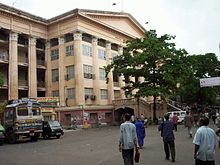West Bengal schools are run by the state government or by private organisations, including religious institutions. Instruction is mainly in English or Bengali, though Urdu are also used, especially in Central Kolkata. The secondary schools are affiliated with the Council for the Indian School Certificate Examinations (CISCE), the Central Board for Secondary Education (CBSE), theNational Institute of Open School (NIOS) or the West Bengal Board of Secondary Education. Under the 10+2+3 plan, after completing secondary school, students typically enroll for 2 years in a junior college, also known as pre-university, or in schools with a higher secondary facility affiliated with the West Bengal Council of Higher Secondary Education or any central board. Students choose from one of three streams, namely, liberal arts, commerce or science. Upon completing the required coursework, students may enroll in general or professional degree programs.
West Bengal has eighteen universities. The University of Calcutta, one of the oldest and largest public universities in India, has more than 200 affiliated colleges. Kolkata has played a pioneering role in the development of the modern education system in India. It is the gateway to the revolution of European education. Sir William Jones (philologist) established the Asiatic Society in 1794 for promoting oriental studies. People like Ram Mohan Roy, David Hare, Ishwar Chandra Vidyasagar and William Carey played a leading role in the setting up of modern schools and colleges in the city. The Fort William College was established in 1810. The Hindu College was established in 1817. In 1855 the Hindu College was renamed as the Presidency College. The Bengal Engineering & Science University and Jadavpur University are prestigious technical universities. Visva-Bharati University at Santiniketan is a central university and an institution of national importance. The state has several higher education institutes of national importance including the Indian Statistical Institute, Indian Institute of Technology Kharagpur (the first IIT of the country), West Bengal National University of Juridical Sciences, Indian Institute of Foreign Trade, the Indian Institute of Management Calcutta (the first management institute in India of its kind) and the National Institute of Technology, Durgapur (formerly Regional Engineering College, Durgapur). After 2003 the state govt supported the creation of West Bengal University of Technology, West Bengal State University and Gour Banga University. Besides these, the state also has Kalyani University, The University of Burdwan and North Bengal University-all well established and nationally renowned, to cover the educational needs at the district levels of the state and also an Indian Institute of Science Education and Research, Kolkata. Also recently Presidency College, Kolkata became a University named Presidency University. Apart from this there is another private university run by Ramakrishna mission named Ramakrishna Mission Vivekananda University at Belur Math. There are a number of research institutes in kolkata. The Indian Association for the Cultivation of Science is the first research institute in Asia. C. V. Raman got Nobel Prize for his discovery (Raman Effect) done in IACS. Also Bose Institute, Saha Institute of Nuclear Physics, S.N. Bose National Centre for Basic Sciences are most prominent. A large number of Indian Scholars are educated at different universities in Bengal. State has produced likes of Jagadish Chandra Bose, Satyendra Nath Bose and RC Bose.



No comments:
Post a Comment